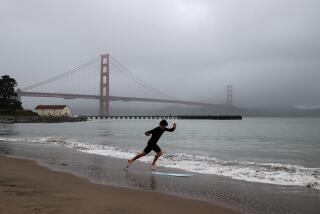Fight Expected on Capture Permit : Sea World Must Get Whales, Ex-Officer Says
Sea World of San Diego, whose five-year permit to capture Alaskan killer whales was declared invalid last week by a federal judge, will likely either appeal the judge’s decision, file for a new permit or seek to import whales captured outside of U.S. territorial waters.
That was the assessment offered Tuesday by David M. DeMotte, the aquatic theme park’s former president, who predicted that Sea World’s attendance will drop if it is deprived of eventual replacements for its stock of popular killer whales.
“There is no question that ‘Shamu’ the killer whale is Sea World’s biggest draw,” DeMotte said. “The whales are getting older and have a certain mortality . . . If those animals were no longer available, it would detract from Sea World’s shows and hurt attendance. They have to try and get new killer whales.”
DeMotte, who headed the theme park from its inception in 1964 until 1981, pointed out that Sea World has constructed a new, $15-million salt-water tank in Florida to accommodate anticipated additional killer whales. The company also is planning to build a similar facility in San Diego.
“Given the investments that they’ve made, they’re simply not going to walk away from this plan, especially when they are in the right, as they are,” DeMotte said. “There are thousands of these whales all over the world. Sea World would never harm one. If they can’t capture them in Alaska, they may request permission to get them from some place like Mexico or Norway--where they can collect quietly in a place where you don’t have a lot of people around.”
If Sea World officials agreed with DeMotte’s ideas, they weren’t saying so Tuesday. The park continued its “no comment” policy on last week’s federal court ruling, which was made public Monday.
“We still have to study the decision,” said Sea World spokeswoman Jackie Hill. “We’re not rushing into anything.”
Sea World maintains eight killer whales at its three parks in San Diego, Ohio and Florida. Last year, nearly 7.1 million people--including 2.97 million in San Diego--visited the three parks to watch, among other aquatic attractions, the highly intelligent black and white whales.
Most of the animals were captured years ago in Icelandic waters, before officials there requested that no more be taken.
In November, 1983, after public hearings were held in Seattle, Sea World received permission from the National Marine Fisher ies Service to capture killer whales at three locations along the Alaskan coast. Under the plan, Sea World would corral 100 killer whales over five years. Ninety would be detained briefly and subjected to various scientific testing before being released.
The remaining 10 killer whales would be taken into permanent captivity to be displayed and trained to perform at Sea World’s three parks. Sea World officials also had hoped that their new killer whales would mate and produce calves--eliminating the need for future whale captures.
Sea World did not attempt whale captures in Alaska in 1983 or 1984, after receiving widespread opposition there from environmentalists and state officials alike. Led by the Sierra Club Legal Defense Fund, a coalition of environmental groups sued in May to stop the whale captures before they began.
Acting on that lawsuit last week, U.S. District Judge James A. von der Heydt in Anchorage ruled that the fisheries service erred in issuing Sea World the permit because officials of the aquatic park did not properly submit an environmental impact study beforehand.
DeMotte said Tuesday that he believes Sea World committed a “strategic error” in seeking permission to capture 100 killer whales.
“It’s an emotional issue,” he said. “You get a lot of people angry if you say you want to capture just one whale, let alone 100.”
DeMotte today is president of Rough Country Inc., an El Cajon-based automotive parts distributor, but he knows well the controversy of killer whale captures. He was head of Sea World in 1976 when the park, armed with a federally approved permit, attempted killer whale captures in the shallow waters off Olympia, Wash.
The frantic capture effort, witnessed by thousands of people who had gathered on the shoreline to watch, enraged Washington state officials. State voters later approved a law prohibiting any attempt to harass or capture killer whales along Washington’s coast.
“Killer whales are so powerful and beautiful, it’s easy to understand why people have such an affection for them,” Demotte said. “If Sea World did not have killer whales, it would still be a very fine park. But without them, a visit to Sea World would be, say, 80% of what it can be. And that loss of 20% would hurt Sea World, there’s no doubt.”
More to Read
Sign up for Essential California
The most important California stories and recommendations in your inbox every morning.
You may occasionally receive promotional content from the Los Angeles Times.










